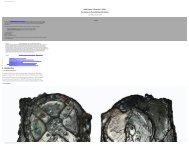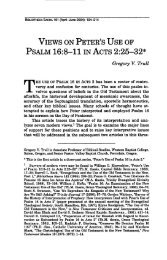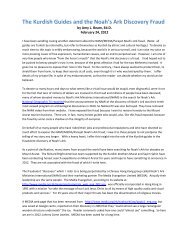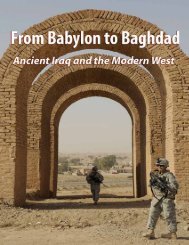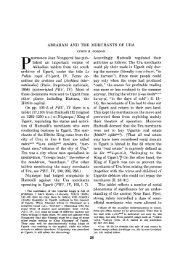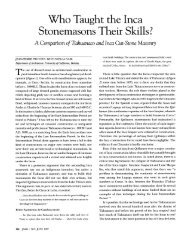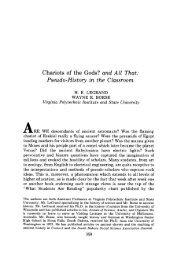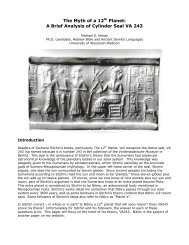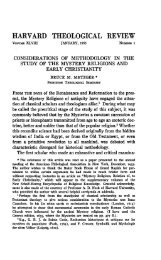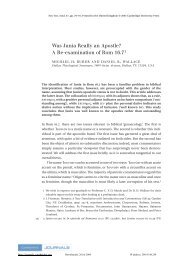Adam's Ancestors - Michael S. Heiser
Adam's Ancestors - Michael S. Heiser
Adam's Ancestors - Michael S. Heiser
Create successful ePaper yourself
Turn your PDF publications into a flip-book with our unique Google optimized e-Paper software.
<strong>Adam's</strong> <strong>Ancestors</strong>: An Interview with David N. Livingstone<br />
Donald A. Yerxa<br />
Historically Speaking, Volume 10, Number 3, June 2009, pp. 10-12 (Article)<br />
Published by The Johns Hopkins University Press<br />
DOI: 10.1353/hsp.0.0041<br />
For additional information about this article<br />
http://muse.jhu.edu/journals/hsp/summary/v010/10.3.yerxa01.html<br />
Access Provided by Liberty University at 11/02/10 4:59AM GMT
10<br />
Historically Speaking • June 2009<br />
again. She died in 1800, having asked for a figure of<br />
Justice to stand guard at her tomb in Westminster<br />
Abbey.<br />
Although Mary won landmark cases, it was<br />
many more years before women enjoyed equal rights<br />
within marriage. In 1857 the Matrimonial Causes Act<br />
established a divorce court in which both sexes could<br />
seek a full divorce. The only grounds were adultery,<br />
and women still had to prove further injustice, such<br />
as cruelty, desertion, or sodomy. In 1923 women<br />
were awarded equal rights in seeking divorce, but<br />
only in 1969 was the principle of divorce for incompatibility<br />
recognized. It was 1870 before women<br />
were allowed to keep income they earned during<br />
marriage and 1882 before this was extended to all<br />
property. In 1839 the Infant Custody Act gave courts<br />
discretion to award custody of children under seven<br />
to mothers, but it was not until 1925 that mothers<br />
and fathers were viewed equally in custody battles.<br />
A journalist and freelance writer, Wendy Moore is the<br />
author of The Knife Man: The Extraordinary<br />
Life and Times of John Hunter, Father of<br />
Modern Surgery (Broadway Books, 2005), as well<br />
as Wedlock: The True Story of the Disastrous<br />
Marriage and Remarkable Divorce of Mary<br />
Eleanor Bowes, Countess of Strathmore<br />
(Crown, 2009), from which this essay is drawn.<br />
1 For background information on the history of marriage and<br />
divorce see Lawrence Stone, Broken Lives: Separation and Divorce in<br />
England, 1660-1857 (Oxford University Press, 1993); The Family,<br />
Sex and Marriage in England, 1500-1800 (Penguin 1977); and Road<br />
to Divorce: A History of the Making and Breaking of Marriage in England,<br />
1530-1987 (Oxford University Press, 1990). See also Roder-<br />
ick Phillips, Putting Asunder: A History of Divorce in Western Society<br />
(Cambridge University Press, 1988); and Untying the Knot: A Short<br />
History of Divorce (Cambridge University Press, 1991).<br />
2 George Savile, Marquis of Halifax, The Ladys New-years Gift: or,<br />
advice to a daughter (London, 1688), 25.<br />
3 Mary Astell, Some Reflections upon Marriage, (London, 1700), 12.<br />
4 Lady Mary Wortley Montagu to Philippa Mundy, April 1712, in<br />
Robert Halsband, ed., The Complete Letters of Mary Wortley Montagu<br />
(Oxford University Press, 1965), 1: 122.<br />
5 Hester Chapone, cited in Bridget Hill, Eighteenth-Century Women:<br />
An Anthology (Unwin Hyman, 1984), 74.<br />
6 Stone, The Family, Sex and Marriage in England, 189-190.<br />
7 François de la Nothe-Fénelon de Salignac, Instructions for the Education<br />
of a Daughter, trans. George Hickes (London, 1713), 13.<br />
8 Mary Eleanor Bowes, Confessions of the Countess of Strathmore<br />
(London, 1793), 44.<br />
9 Ibid, 65-66.<br />
ADAM’S ANCESTORS:<br />
AN INTERVIEW WITH DAVID N. LIVINGSTONE<br />
DAVID N. LIVINGSTONE IS A PROFESSOR OF GEOGRAPHY<br />
and intellectual history at Queen’s University Belfast. He is a fellow of the British<br />
Academy and the Royal Society of Arts. One of the most talented and perceptive scholars<br />
currently working on the history of science and religion, Livingstone is especially interested<br />
in exploring the spatial as well as the temporal contexts within which ideas are<br />
produced and consumed. Among his many books are Putting Science in Its Place:<br />
Donald A. Yerxa: Your most recent book,<br />
Adam’s <strong>Ancestors</strong>, is a history of pre-Adamite<br />
thinking. What is pre-Adamism?<br />
David N. Livingstone: Pre-Adamism is actually<br />
a notoriously simple idea, though its<br />
consequences are multifaceted. It’s the<br />
idea that the Adam of the Hebrew<br />
Bible and the Old Testament is not the<br />
first human being. In some incarnations<br />
Adam is simply the father of the<br />
Jewish people, whereas in other versions<br />
Adam is viewed as the father of<br />
Caucasian people. But the material<br />
point of pre-Adamism, at least in its<br />
early days, is that there were, and perhaps<br />
indeed continue to exist, peoples<br />
who are descended from a pre-Adamic<br />
or at least non-Adamic source. This<br />
would mean that there were at least<br />
two (and arguably more than two) creations of the<br />
human species. In pre-Adamism lie the origins of<br />
what anthropologists used to call polygenesis. And,<br />
indeed, that has been and continues to be something<br />
of an issue right up to contemporary paleoanthropology.<br />
Should we look at all humans as<br />
Conducted by Donald A. Yerxa<br />
derived from a single source, let’s say, a “mitochondrial<br />
Eve”? Or did the human species emerge in<br />
many different places? So the debate in that sense,<br />
without the biblical significance of Adam, continues<br />
to be important in thinking about human ori-<br />
Pre-Adamism was considered heretical<br />
because it plainly challenged a literal<br />
reading of the Genesis narrative. One<br />
has to rethink a sequence of other related<br />
theological precepts if one accepts<br />
the notion that there were pre-Adamites.<br />
gins more generally.<br />
Yerxa: How significant was pre-Adamism in<br />
Western intellectual history prior to Darwin?<br />
Livingstone: There are a couple of things to be<br />
Geographies of Scientific Knowledge (University of Chicago Press, 2003) and<br />
most recently Adam’s <strong>Ancestors</strong>: Race, Religion, and the Politics of Human<br />
Origins (Johns Hopkins University Press, 2008). Historically Speaking senior<br />
editor Donald A. Yerxa caught up with Livingstone on March 3, 2009, to discuss his<br />
latest book as well as his approach to intellectual history.<br />
said about this. Another historian who worked on<br />
this subject some years ago, Richard Popkin, made<br />
the arresting suggestion that pre-Adamic theory<br />
was much more destabilizing to European intellectuals<br />
in the 17th century than the Copernican revolution<br />
or indeed the mechanical<br />
universe of the Newtonians. Popkin<br />
reasoned that pre-Adamism challenged<br />
human beings’ sense of their<br />
own identity, of who they really were.<br />
For a very long time, going back to<br />
the church fathers, to Augustine, and<br />
indeed to much earlier times, descent<br />
from Adam came to be a definition<br />
of what it was to be human. So I’m<br />
inclined to agree with Popkin because<br />
while you can scarcely find an advocate<br />
for the idea after 1655 when it<br />
first began to achieve wider publicity,<br />
you find many, many refutations. Although<br />
pre-Adamism seems initially to have had<br />
few converts, a lot of people felt the need to refute<br />
it.<br />
Yerxa: Throughout your book it is clear that<br />
this notion is quite versatile and can be
adapted to a number of arguments. Could you<br />
speak to that?<br />
Livingstone: Pre-Adamism can be used for many<br />
contradictory purposes and is hugely<br />
adaptable in different environments. Let<br />
me just pick out three or four of these.<br />
Initially, when it was first put forward in<br />
the 1650s by Isaac La Peyrère, it was rapidly<br />
castigated as a heresy. Emissaries<br />
from the Vatican picked up La Peyrère<br />
when he was traveling in what is now<br />
Belgium and took him off to Rome,<br />
where he was forced to recant before the<br />
pope. Clever devil that La Peyrère was,<br />
however, the recantation never really admitted<br />
he was wrong. Pre-Adamism was<br />
considered heretical because it plainly<br />
challenged a literal reading of the Genesis<br />
narrative. One has to rethink a sequence<br />
of other related theological<br />
precepts if one accepts the notion that<br />
there were pre-Adamites. For example,<br />
did they also fall from grace? How representative<br />
is Adam of the human race?<br />
How does original sin come into the<br />
world? How is it transmitted?<br />
Pre-Adamism has been quite versatile,<br />
however. In the 19th century—and<br />
indeed on into the 20th century—the<br />
idea was promulgated by those who were<br />
much more conservative in their theological<br />
outlook. It was adopted in a new<br />
guise by conservative believers who<br />
wanted to hold onto the historic signifi-<br />
cance of Adam while at the same time<br />
take some notion of human evolution seriously.<br />
So pre-Adamism, once deemed a<br />
massive heresy, was later taken up by<br />
conservative, orthodox believers.<br />
Let me provide another instance of its adaptability.<br />
In the 1650s La Peyrère thought that Adam<br />
was the father of the Jewish race, but he was convinced<br />
that we all, whether Jews or not, participate<br />
to some degree in the benefits of the Jewish religious<br />
tradition and divine action in the world<br />
through the children of Israel. So in that sense,<br />
pre-Adamism is inclusive, humanitarian, and<br />
sweeps all of humanity—whether Jewish, Adamic<br />
or non-Jewish, non-Adamic—into a human family<br />
that benefits in Israel’s redemption. But later, pre-<br />
Adamism was used for the grossest forms of<br />
racism by depicting certain racial groups as non-<br />
Adamic and thus inferior and perhaps even subhuman.<br />
So pre-Adamism has been used for both<br />
humanitarian and racist purposes.<br />
Yerxa: In what form has pre-Adamism survived<br />
into the present era?<br />
Livingstone: In a literal understanding of pre-<br />
Adamism, the notion of the pre-Adamite only<br />
makes sense if you believe that Adam was a historic<br />
individual and continues to have some significance.<br />
So pre-Adamism still matters for some<br />
conservative evangelical Protestants and conservative<br />
Catholics. For both of these groups, the story<br />
of Adam, the inheritance of original sin, and the<br />
significance of Adam in a representative capacity<br />
An illustration of Adam and Eve from Thomas Hariot, A Briefe and True Report of<br />
the New Found Land of Virginia (London, 1590). Beinecke Rare Book and Manuscript<br />
Library, Yale University.<br />
comparable to that of Christ are still important.<br />
The scientifically literate among these conservative<br />
evangelicals and Catholics want to hold on to the<br />
notion of Adam and also accept the theory of<br />
human evolution. So they are willing to consider<br />
that the human body may have undergone evolutionary<br />
transformation to a point where by divine<br />
action a creature was humanized into the first<br />
human form by becoming “en-souled” or receiving<br />
the image of God or some such. The hominid<br />
predecessors of the first true human would be<br />
considered pre-Adamic, almost but not quite<br />
human in a fully theological sense.<br />
Pre-Adamism also survives much more scarily<br />
among a small group of right-wing racial supremacists,<br />
particularly in the United States, known as<br />
the Christian Identity Movement. This group has<br />
resurrected 18th- and 19th-century pre-Adamic literature<br />
to try to make a case that there are two<br />
distinct bloodlines existing right up to the present<br />
day, one being the Adamic bloodline, mostly considered<br />
to be Caucasian, and another pre- or non-<br />
Adamic “seedline” going back to some mythical<br />
and presumed liaison between Eve and the devil.<br />
Yerxa: Pre-Adamism has been employed, as<br />
June 2009 • Historically Speaking 11<br />
you’ve indicated, as a way of harmonizing systems<br />
of science and religion. But you contend<br />
that such intellectual devices do not function<br />
simply as “bridges between two independent<br />
domains.” They are mutually transformative.<br />
How is that the case?<br />
Livingstone: Pre-Adamism is one of<br />
many schemes that religious believers<br />
have elaborated over the years for trying<br />
to retain some kind of harmony between<br />
a set of theological commitments and the<br />
deliverances of empirical science. For example,<br />
there is the idea, going back at<br />
least to the late 18th and early 19th centuries,<br />
that each of the days of creation<br />
in Genesis might be interpreted as geological<br />
epochs. The so-called Gap Theory,<br />
the notion that there may be a vastly long<br />
gap of time between the first verse of<br />
Genesis and the second verse, is another<br />
one of these harmonizing schemes. The<br />
argument I am trying to make is that<br />
these attempts at harmonization are never<br />
a neutral zipping together of two disparate<br />
schemes. Adopting one of these<br />
harmonizing strategies has implications<br />
for how people think both about the science<br />
and also about their religion. Let me<br />
use the pre-Adamic scheme as a case in<br />
point. If you are an orthodox Christian<br />
believer in the 17th century, you are confronted<br />
with problems. Egyptian chronology<br />
turns out to be much longer than<br />
the chronology that is available from the<br />
biblical narratives. So you look at socalled<br />
“pagan chronicles,” and you think<br />
one way to resolve the tension is to view<br />
the biblical chronology as only the story<br />
of Jewish descent from Adam; that<br />
would allow other older chronologies to predate<br />
the Genesis account. Or in the wake of Europe’s<br />
first encounters with the Americas, you wonder<br />
how these regions came to be inhabited. Then you<br />
think to yourself that maybe human beings were<br />
specifically created in the New World, and there<br />
was a non- or co-Adamic creation. So you adopt<br />
pre-Adamite schemes to resolve problems like<br />
these.<br />
Scientifically that commits you, for example, to<br />
answering a certain set of questions: Are these<br />
separately created human beings? Are they all the<br />
same kind of human being? Is a polygenetic account<br />
the best way to think about human history?<br />
If you’re committed to that, then there might be<br />
an implication for the way you think about the development<br />
of language. Would all languages have<br />
come from one source, or would they have been<br />
created as separate language groups across the face<br />
of the Earth? Adopting pre-Adamism leads to a<br />
series of scientific questions, and you then find<br />
yourself committed not just to polygenesis with respect<br />
to anthropology, but also with respect to culture,<br />
linguistics, and philology. It also raises<br />
theological questions: Do all human beings partic-
12<br />
Historically Speaking • June 2009<br />
ipate in Adam’s fall from grace? Does Adam represent<br />
all humanity, or do people have to be physically<br />
descended from Adam to inherit original sin?<br />
What about the benefits of redemption?<br />
Do they only extend to Adam’s successors,<br />
or do they extend to non-Adamic<br />
people? How do we understand the<br />
image of God? How should we read the<br />
biblical documents? Should we read them<br />
metaphorically? My point is that these<br />
harmonizing strategies fold out in many<br />
directions and raise scientific questions as<br />
well as theological ones. They are not<br />
simply neutral; they interrogate the two<br />
sides that they are actually trying to hold<br />
together.<br />
Yerxa: And what are the implications<br />
of this for the many efforts currently<br />
underway to bring science and religion<br />
into closer dialogue?<br />
Livingstone: You would need to ask<br />
someone who is involved with the current<br />
debates over science and religion to<br />
see if this sort of idea pertains there. For<br />
instance, certain understandings about the<br />
quantum world or contemporary physics<br />
have prompted some to turn to Eastern<br />
ways of thinking about physics. You have<br />
the Tao of physics and things of this<br />
sort. I do not know that literature well<br />
enough, but my initial suspicion is that<br />
any of these reconciling mechanisms will<br />
not simply be a glue to hold two things<br />
together. They will transform how people<br />
think about the two sides that they are<br />
trying to tie together.<br />
Yerxa: You were trained as a geographer,<br />
and yet much of your recent<br />
writing has been in the area of intellectual<br />
history and the history of science. Is<br />
this an unusual intellectual trajectory? Or is<br />
this question premised on a false assumption<br />
about what it is that geographers do?<br />
Livingstone: Being trained in geography in my<br />
generation encompassed aspects of physical science<br />
as well as the humanities and social sciences.<br />
Geography integrates nature and culture, or environment<br />
and society. Since its institutionalization<br />
in the 19th century, geography has always had considerable<br />
interest in the history of exploration. If<br />
you go back to early examination papers at the<br />
University of Oxford, you will find papers dealing<br />
with the history of what was then called, in those<br />
colonially unconscious days, the Age of Discovery<br />
or the Age of Exploration. So there was always<br />
interest in the history of growing geographical<br />
knowledge about the globe. When I was an undergraduate,<br />
I took a two-year-long course on the history<br />
of ideas about geography and was entirely<br />
captivated by this. It brought in not only the history<br />
of culture and the history of civilization, but<br />
also certain aspects of the history of knowledge.<br />
There is still a small but intellectually vibrant group<br />
of geographers working on the history of ideas<br />
From Francis Darwin, ed., The Life and Letters of Charles Darwin, Vol 1 (London,<br />
1896).<br />
about nature and culture. Two influential 20th-century<br />
geographers were Clarence Glacken, whose<br />
Traces on the Rhodian Shore is fundamentally an intellectual<br />
history of nature and culture since ancient<br />
times, and John Kirtland Wright, at one time director<br />
of the American Geographical Society and<br />
the author of The Geographical Lore of the Time of<br />
the Crusades. This tradition continues with Charles<br />
Withers at the University of Edinburgh, who<br />
writes on the geographies of the Enlightenment,<br />
and Felix Driver at Royal Holloway, who studies<br />
the historical geography of exploration. In my<br />
work I emphasize the geography of scientific ideas.<br />
It is very important to know where scientific ideas<br />
were put forward; where they were received; how<br />
they were read in a particular space, time, and situation.<br />
Location plays a key role in the production,<br />
circulation, and consumption of scientific knowledge.<br />
When I wrote Putting Science in Its Place<br />
(2003), I tried to organize the book around specifically<br />
geographical notions like space, region, migration,<br />
movement, and things of this sort. The<br />
point was to encourage us to think spatially, not<br />
just temporally about the scientific enterprise.<br />
Yerxa: In what directions are you taking this<br />
approach to space in relation to knowledge?<br />
Livingstone: There are two projects that<br />
I am sort of teetering with, one a bit<br />
more advanced than the other. I claim to<br />
be writing what I call a historical geography<br />
of Darwinism. I am very interested in<br />
seeing what Darwinism was taken to mean<br />
in different places across the face of the<br />
globe. For example, did Darwinism mean<br />
the same thing in Wellington, New<br />
Zealand as it did in, say, Toronto, Canada<br />
or Edinburgh, Scotland or Columbia,<br />
South Carolina? I suspect that it did not.<br />
If I am right about this, it will force us to<br />
recast our thinking about religious responses<br />
to Darwinism. If the responses to<br />
Darwinism were very different in the<br />
places I just mentioned, all of which<br />
shared a Reformed Protestant theology,<br />
then we can’t speak any longer about the<br />
relationship between Catholicism and Darwinism<br />
or evangelicalism and evolutionism.<br />
In each case we have to try to get a<br />
bit more local and place these encounters<br />
in very particular circumstances. You and<br />
I have talked before about this in a different<br />
setting. You are concerned that an<br />
overemphasis on the local runs the risk of<br />
moving so far from generalization that we<br />
can’t say anything. That would be a mistake.<br />
We should still be able to say something<br />
general without lapsing into an easy<br />
caricature about what, say, evangelicalism<br />
or Catholicism must have thought about<br />
Darwinism in the 19th century.<br />
The other project I want to do is a<br />
history of the idea of climatic determinism.<br />
I think underlying many of our anxieties<br />
about global warming and climate change is a very<br />
ancient idea that in some powerful way climate is<br />
going to punish us for not behaving properly. I<br />
have a suspicion that some of the rhetoric we have<br />
in the contemporary debate is not unlike what we<br />
might find if we look back to the 18th, 17th, and<br />
16th centuries. I would like to do an intellectual<br />
genealogy of the idea that, to use Montesquieu’s<br />
phrase, “the empire of the climate is the first, the<br />
most powerful of all empires.”



